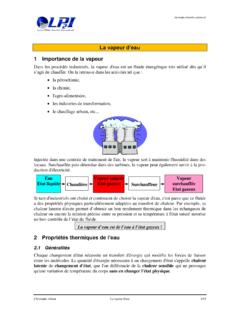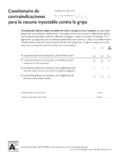Transcription of Outline of a Sociological Theory of Art Perception
1 From: Pierre Bordieu The Field of Cultural Production: Essays on Art and Literature 1984, Columbia University Press Part III: The Pure Gaze: Essays on Art, Chapter 8. Outline of a Sociological Theory of Art Perception . PIERRE BOURDIEU. 1. Any art Perception involves a conscious or unconscious deciphering operation. An act of deciphering unrecognized as such, immediate and adequate comprehension', is possible and effective only in the special case in which the cultural code which makes the act of deciphering possible is immediately and completely mastered by the observer (in the form of cultivated ability or inclination) and merges with the cultural code which has rendered the work perceived possible. Erwin Panofsky observes that in Rogier van der Weyden's painting The Three Magi we immediately perceive the representation of an apparition' that of a child in whom we recognize the Infant Jesus'.
2 How do we know that this is an apparition? The halo of golden rays surrounding the child would not in itself be sufficient proof, because it is also found in representations of the nativity in which the Infant Jesus is real'. We come to this conclusion because the child is hovering in mid-air without visible support, and we do so although the representation would scarcely have been different had the child been sitting on a pillow (as in the case of the model which Rogier van der Weyden probably used). But one can think of hundreds of pictures in which human beings, animals or inanimate objects appear to be hovering in mid-air, contrary to the law of gravity, yet without giving the impression of being apparitions. For instance, in a miniature of the Gospels of Otto III, in the Staatshibliothek, Munich, a whole town is represented in the middle of an empty space, while the persons taking part in the action are standing on the ground.
3 This actually is a real town, where the resurrection of the young people shown in the foreground took place. If, in a split second and almost automatically, we recognize the aerial figure as an apparition, whereas we see nothing miraculous about the city floating in the air, it . Chapter 8, Outline of a Sociological Theory of Art Perception ', was originally published as l ments d'une th orie sociologique de la Perception artistique', Revue internationale des sciences sociales, special issue on Les arts dans la soci t , 20/4 (1968), pp. 5-14. The English translation first appeared in International Social Science Journal, 20 (Winter 1968), pp. 589-612. is because we are reading what we see according to the manner in which the objects and events are expressed by forms under varying historical conditions';. more precisely, when we decipher a miniature of AD, we unconsciously assume that the empty space serves merely as an abstract, unreal background instead of forming part of an apparently natural, three-dimensional space, in which the supernatural and the miraculous can appear as such, as in Rogier van der Weyden's Since they unconsciously obey the rules which govern a particular representation of space when they decipher a picture constructed according to these rules, the educated or competent beholders of our societies can immediately apprehend as a supernatural vision' an element which, by reference to another system of representations in which the regions of space would be in some way juxtaposed' or aggregated' instead of being integrated into a single representation, might appear natural' or real'.
4 The perspective concept', says Panofsky, makes it impossible for religious art to enter the realm of magic .. but opens to it a completely new realm, that of the visionary in which the miracle becomes an experience immediately perceived by the beholder, because supernatural events burst into the apparently natural visible space which is familiar to him, and thus enable him truly to penetrate into the essence of the supernatural.'2. The question of the conditions that make it possible to experience the work of art (and, in a more general way, all cultural objects) as at once endowed with meaning is totally excluded from the experience itself, because the recapturing of the work's objective meaning (which may have nothing to do with the author's intention) is completely adequate and immediately effected in the case and only in the case where the culture that the originator puts into the work is identical with the culture or, more accurately, the artistic competence which the beholder brings to the deciphering of the work.
5 In this case, everything is a matter of course and the question of the meaning, of the deciphering of the meaning and of the conditions of this deciphering does not arise. Whenever these specific conditions are not fulfilled, misunderstanding is inevitable: the illusion of immediate comprehension leads to an illusory comprehension based on a mistaken In the absence of the Perception that 1. E. Panofsky, Iconography and Iconology: An Introduction to the Study of Renaissance Art', Meaning in the Visual Arts (New York: Doubleday, 1955), pp. 33-5. 2. E. Panofsky, Die Perspektive als symbolische Form', Vortr ge der Bibliothek Warburg: Vortr ge 1924-25, pp. 257ff. 3. Of all misunderstandings involving the code, the most pernicious is perhaps the humanist' misunderstanding, which, through negation, or rather, 2. the works are coded, and coded in another code, one unconsciously applies the code which is good for everyday Perception , for the deciphering of familiar objects, to works in a foreign tradition.
6 There is no Perception which does not involve an unconscious code and it is essential to dismiss the myth of the fresh eye', considered a virtue attributed to na vet and innocence. One of the reasons why the less educated beholders in our societies are so strongly inclined to demand a realistic representation is that, being devoid of specific categories of Perception , they cannot apply any other code to works of scholarly culture than that which enables them to apprehend as meaningful objects of their everyday environment. Minimum, and apparently immediate, comprehension, accessible to the simplest observers and enabling them to recognize a house or a tree, still presupposes partial (unconscious) agreement between artist and beholder concerning categories that define the representation of the real that a historic society holds to be realistic' (see note 4).
7 The spontaneous Theory of art Perception is founded on the experience of familiarity and immediate comprehension an unrecognized special case. Educated people are at home with scholarly culture. They are consequently carried towards that kind of ethnocentrism which may be called class-centrism and which consists in considering as natural (in other words, both as a matter of course and based on nature) a way of perceiving which is but one among other possible ways and which is acquired through education that may be diffuse or specific, conscious or unconscious, institutionalized or non- institutionalized. When, for instance, a man wears a pair of spectacles which are so close to him physically that they are sitting on his nose , they are environmentally more remote from him than the picture on the opposite wall. Their proximity is normally so weakly perceived as to go unnoticed.
8 ' Taking Heidegger's analysis metaphorically, it can be said that the illusion of the fresh eye' as a naked eye' is an attribute of those who wear the spectacles of culture and who do not see that which enables them to see, any more than they see what they would not see if they were deprived of what enables them to neutralization', in the phenomenological sense, of everything which contributes to the specificity of the cultures arbitrarily integrated into the pantheon of universal culture', tends to represent the Greek or the Roman as a particularly successful achievement of human nature' in its universality. 4. This is the same ethnocentrism which tends to take as realistic a representation of the real which owes the fact that it appears objective' not to its concordance with the actual reality of things (because this reality' is never perceptible except through socially conditioned forms of apprehension) but to its conformity with rules which define its syntax in its social usage with a social definition of the objective vision of the world; in applying the stamp of realism to certain 3.
9 Conversely, faced with scholarly culture, the least sophisticated are in a position identical with that of ethnologists who find themselves in a foreign society and present, for instance, at a ritual to which they do not hold the key. The disorientation and cultural blindness of the less-educated beholders are an objective reminder of the objective truth that art Perception is a mediate deciphering operation. Since the information presented by the works exhibited exceeds the deciphering capabilities of the beholder, he perceives them as devoid of signification or, to be more precise, of structuration and organization . because he cannot decode' them, reduce them to an intelligible form. Scientific knowledge is distinguished from na ve experience (whether this is shown by disconcertment or by immediate comprehension) in that it involves an awareness of the conditions permitting adequate Perception .
10 The object of the science of the work of art is that which renders possible both this science and the immediate comprehension of the work of art, that is, culture. It therefore includes, implicitly at least, the science of the difference between scientific knowledge and na ve Perception . The na ve beholder differs from the art historian in that the latter is conscious of the situation.'5 Needless to say, there would probably be some difficulty in subsuming all the genuine art historians under the concept Panofsky defines in an excessively normative fashion. 2. Any deciphering operation requires a more or less complex code which has been more or less completely mastered. The work of art (like any cultural object) may disclose significations at different levels according to the deciphering grid applied to it; the lower-level significations, that is to say the most superficial, remain partial and mutilated, and therefore erroneous, as long as the higher-level significations which encompass and transfigure them are lacking.














